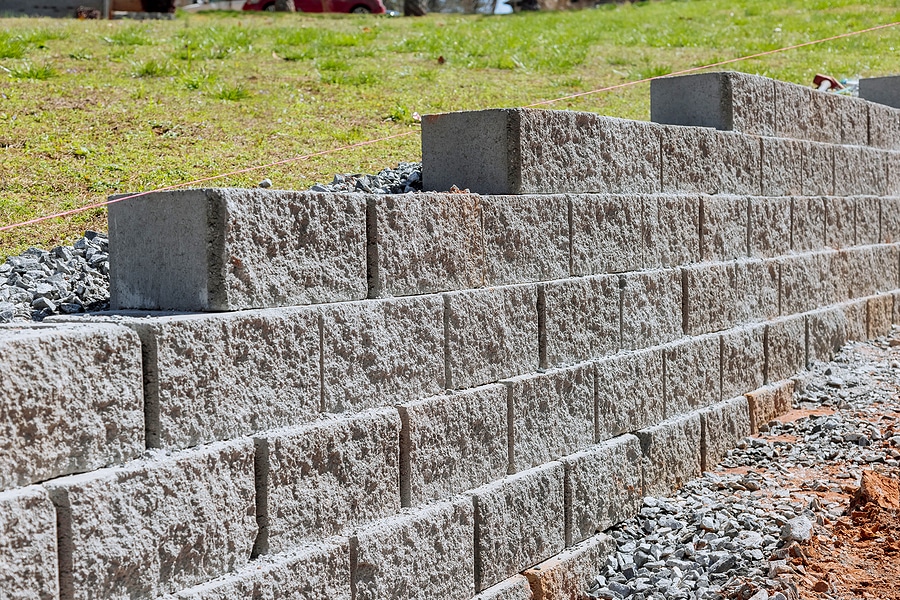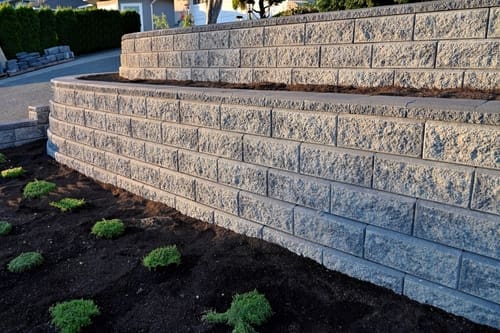Key Factors To Consider for Building Efficient Retaining Walls in Your Lawn
When you're taking into consideration building a maintaining wall surface in your yard, it's important to believe regarding a number of crucial aspects. The wall surface's objective, the products you'll use, and the particular dirt problems can all impact its effectiveness and durability.
Comprehending the Objective of Your Retaining Wall
When you consider building a retaining wall surface, consider its primary purpose: stabilizing soil and stopping erosion. Retaining walls offer vital assistance for sloped landscapes, aiding to keep dirt integrity. You'll discover they're essential in areas where water overflow may otherwise clean away soil, causing costly fixings and landscape damages.
By keeping back planet, these walls create level surfaces for yards, patio areas, or paths. This not only boosts your lawn's visual appeals yet also advertises far better drain, decreasing water pooling in undesirable locations. If you're handling steep slopes, a well-constructed retaining wall surface can protect against landslides, guaranteeing safety and security for you and your home.
Eventually, recognizing the purpose of your retaining wall surface will certainly assist your style decisions and assist you produce a useful, sturdy structure that satisfies your requirements. Take a minute to review your landscape; it'll pay off in the long run.
Selecting the Right Materials
When choosing products for your retaining wall, you'll desire to think about sturdiness, looks, and expense. Each aspect plays an important role in guaranteeing your wall stands the examination of time while looking wonderful and fitting your budget plan. Let's check out how to make the finest choices for your task.
Material Longevity Variables
Picking the appropriate materials is essential for the long life and efficiency of your retaining wall, since their sturdiness straight influences the wall's ability to withstand environmental stress and anxieties. Begin by considering your local climate; materials like concrete and rock stand up to moisture and temperature level variations well. If you stay in an area vulnerable to heavy rains, select products with great drain buildings, like crushed rock or porous blocks, to stop water build-up.
Some materials carry out much better in certain dirt types, so it's crucial to match them as necessary. Selecting durable materials assurances your retaining wall surface stands solid, safeguarding your backyard for years to come.
Aesthetic Design Options
Durable materials not only assure your retaining wall surface's architectural integrity but also play an essential role in its visual allure. When picking the appropriate products, assume concerning just how they enhance your landscape. Natural rock uses an ageless, rustic appearance, while cinder block can supply a smooth, modern-day finish. You might likewise think about using timber for a warm, natural feeling. Color and texture matter, too; pick tones that balance with your home and garden. Do not ignore the wall's form-- bent walls can produce a softer appearance, while straight lines can really feel a lot more organized. By thoroughly selecting products that line up with your aesthetic vision, you'll enhance your exterior area while ensuring your wall stands strong against the elements.
Cost-Effectiveness Evaluation
Choosing the best materials for your retaining wall isn't almost aesthetic appeals; it's also essential for your budget plan. When picking materials, take into consideration both in advance prices and long-lasting resilience. Concrete blocks might be more expensive at first, yet their longevity can save you cash on repairs. On the other hand, lumber can be much more economical yet may require substitute earlier.
Don't forget to consider maintenance costs also (OKC Precision Retaining Walls). Some products, like all-natural rock, can include beauty and require less upkeep, while others may need regular therapies
Ultimately, evaluate the pros and disadvantages of each option against your spending plan and the wall's intended purpose. Investing wisely in materials now can prevent expensive concerns down the roadway. Select products that balance cost and performance effectively.
Assessing Dirt Problems and Drain
As you begin your project, assessing soil problems and drain is crucial for the success of your retaining wall surface. Begin by taking a look at the sort of soil in your yard. Sandy dirt drains well yet lacks stability, while clay dirt can preserve dampness, leading to push on your wall. Check the dirt's moisture material by excavating a tiny hole and observing how quickly it dries.
Next, analyze the slope of your backyard. If water naturally moves towards your wall, you'll require to implement a water drainage option to stop disintegration and stress buildup. Take into consideration setting up perforated pipelines or gravel backfill behind the wall surface to assist in drainage.
Last but not least, observe any type of nearby trees or plants; their roots can affect dirt stability. By recognizing your dirt problems and applying appropriate drain, you'll create a solid foundation for your retaining wall surface that stands the examination of time.
Conforming With Local Structure Codes
Before you start developing your retaining wall surface, you require to research local policies to assure compliance. browse around here It's necessary to comprehend what allows you should get, as this can save you from expensive fines or having to redo your work. Taking these steps seriously will help you develop a secure and effective structure.
Research Study Local Rules
Comprehending local policies is necessary when planning your retaining wall job, particularly considering that developing codes can differ greatly by location. Start by getting in touch with your local structure division or community to learn more about certain demands. Try to find guidelines on wall elevation, products, water drainage systems, and architectural stability. Lots of areas have restrictions on the sorts of products you can utilize and how high you can build. You'll also wish to take right into account the zoning legislations that might influence your job. Disregarding these policies can result in costly penalties or the requirement to redo your job. By doing your research study upfront, you can guarantee your retaining wall surface meets all necessary codes and blends flawlessly into your yard.
Get Needed Licenses
When you've investigated regional guidelines, the following step is to acquire the essential permits for your retaining wall task. They might call for details strategies or design evaluations, specifically for bigger walls. Securing the best approvals can save you from pricey penalties or having to dismantle your wall surface later.

Planning the Design and Looks
As you begin planning the design and aesthetic appeals of your retaining wall, consider just how it will certainly balance with the surrounding landscape. Assume regarding the materials you'll use-- rock, brick, or concrete-- and how they'll enhance your home's design and the natural environments in your lawn. Choose shades and appearances that mix flawlessly with existing functions like patios, pathways, or gardens.
Next, imagine the wall's shape and elevation. Rounded walls can soften a rigid landscape, while straight lines might convey an extra contemporary look. Don't neglect to integrate plants and plant around the wall for an all-natural touch; this can improve its appeal and incorporate it right into the environment.
Last but not least, remember capability. Your design should not just be visually additional info pleasing yet also serve its function effectively. By attentively intending these aspects, you'll create a preserving wall that improves your backyard's charm while meeting its architectural function.
Computing Height and Density Requirements
To develop a strong retaining wall surface, you need to precisely compute its height and thickness needs based upon the soil conditions and the elevation of the incline it will certainly support. Begin by reviewing the slope's angle and the kind of dirt, as various dirts exert varying amounts of pressure.
For walls over four feet high, take into consideration a thickness of at least 12 inches. If the wall surface is taller, raise the density proportionally to maintain stability.
Next, compute the height of the wall by measuring the vertical distance it needs to maintain. For every single foot of elevation, you must typically prepare for a thickness of one-third of the wall's height.
Always keep in mind to represent extra aspects like water drainage and backfill, which can influence your wall's design. Proper computations now guarantee your retaining wall stands strong and lasts for years to come.
Maintenance and Longevity Considerations
While maintaining your retaining wall surface could appear like a reduced concern, disregarding it can lead to substantial concerns with time. Routine evaluations are important; check for fractures, bulges, or any indicators of water damage. Resolving these troubles early can conserve you from pricey repair services in the future.
Watch on water drainage systems, also. Blocked drains pipes can create water to construct up, exerting pressure on your wall and endangering its security. Clear debris and guarantee correct flow to maintain long life.
You might also wish to review sealing your wall surface to secure it from moisture and weathering. Relying on the product, this could need reapplication every few years.
Last but not least, landscaping around your wall surface can support its integrity. Prevent planting large trees close by, as their roots can weaken the foundation. With aggressive maintenance, your retaining wall surface can serve you well for several years to find.

Often Asked Questions
Can I Construct a Retaining Wall by Myself, or Should I Work with an Expert?
You can certainly develop a keeping wall surface yourself if you have the right tools and expertise. Employing a specialist guarantees it's done properly, specifically for larger or more complicated frameworks. Consider your ability level before making a decision.
What Are the A Lot Of Usual Mistakes Made When Structure Retaining Walls?
When constructing retaining walls, you might overlook proper drain, miss using the best products, or forget support. These common mistakes can result in structural failure, so take your time and plan meticulously to avoid issues.
How Do I Know if My Retaining Wall Needs Reinforcement?
You'll know your retaining wall needs reinforcement if you see splits, leaning, or protruding. Examine for water merging behind it or dirt disintegration get more near the base. Address these indicators promptly to avoid further damage.
What Plants Appropriate for Landscaping Around a Retaining Wall?
When landscaping around a retaining wall surface, consider utilizing low-maintenance plants like succulents, ornamental grasses, or creeping ground covers - OKC Precision Retaining Walls. They'll flourish in those problems and add charm while avoiding soil erosion around your wall surface
How Can I Stop Erosion Around My Retaining Wall?
To protect against disintegration around your retaining wall surface, you can grow ground cover, use mulch, and mount water drainage systems. Regularly look for water buildup and change landscape design to reroute overflow far from the wall.